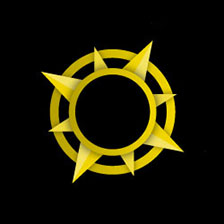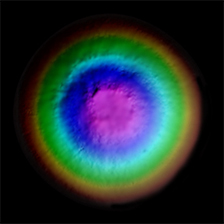Phobos Mars Express HRSC DEM Global 100m
- Primary Authors
- Mars Express HRSC Instrument Team
- Originators
- Europlanet Research Infrastructure
- Publisher
- USGS Astrogeology Science Center
- Publication Date
- 2009-06-01
- Abstract
- Product Information: Images from the European Space Agency's High Resolution Stereo Camera (HRSC) aboard the Mars Express were used to obtain 3-dimensional coordinates of surface points of Phobos. As currently the HRSC could not gain global coverage yet, the data was complimented by Viking orbiter image data to be able to provide the digital elevation model (DEM) globally (Willner et al., 2010). Resolution of this DEM is 100 meters per pixel (m). The research leading to the data products has received funding from the European Community's Seventh Framework Programme ([FP7/2007-2013]) under grant agreement number 263466 for the FP7-ESPaCE program. Mission and Instrument Information: Mars Express is a mission of the European Space Agency (ESA) it launched in June 2003 onboard a Soyuz-Fregat launcher from the Baikonur Cosmodrome in Kazakhstan. There are seven instrument suites onboard Mars Express: Aspera Energetic Neutral Atoms Analyzer (ASPERA), High/Super Resolution Stereo Colour Imager (HRSC, SRC), Mars Radio Science Experiment, Mars Subsurface Sounding Radar/Altimeter (MARSIS), Omega IR Mineralogical Mapping Spectrometer (Omega), Planetary Fourier Spectrometer (PFS), and UV and IR Atmospheric Spectrometer (SPICAM). The instrumentation onboard Mars Express was designed to reach the scientific objectives of the mission which include: global high-resolution photogeology at 10 m per pixel resolution, super resolution photogeology of selected areas of the planet at 2 meters per pixel, global high spatial resolution mineralogical mapping at a resolution range from a kilometer per pixel to several 100 meters per pixel, global atmospheric circulation characterization, subsurface characterization, surface-atmosphere interaction, structure of the interior and surface geochemistry and exobiology. Phobos is a very irregular body often approximated by a tri-axial ellipsoid for simplicity. With a mean distance of only 9375 km to the center of Mars â which relates to approximately 6000 km above the Martian surface â it is orbiting deep in the Martian gravity field. Its orbit is in a nearly equatorial plane and almost circular. Reference: Willner, K., Oberst, J., Hussmann, H., Giese, B., Hoffman, H., Matz, K.-D., Roatsch, T., & Duxbury, T. (2010). Phobos control point network, rotation, and shape. Earth and Planetary Science Letters, 294(3â4), 541-546. https://doi.org/10.1016/j.epsl.2009.07.033
- Purpose
- The German Aerospace Center (DLR) was involved in an in-depth study of Phobos, a natural satellite of Mars. Based on images of the multi-spectral line scanning High Resolution Stereo Camera (HRSC) and the Super Resolution Channel (SRC) â a frame camera â the department of Planetary Geodesy was to observe Phobos in its orbit, determined shape parameters computed global digital elevation models, prepared a first low scale maps based on image data only, derived new estimates on its rotational parameters and could derive mass distribution models agreeing to all other constraining parameters.
Contact and Distribution
- Format
- Digital Elevation Model, Remote-sensing Data, Topographic Map
- Access Constraints
- public domain
- Access Scope
- PDS
- Use Constraints
- Please cite authors
- Edition
- 0.1
- Supplemental Information
- http://www.sciencedirect.com/science/article/pii/S0012821X09004506, https://www.dlr.de/dlr/en/desktopdefault.aspx/tabid-10364/548_read-400/#/gallery/657
- Native Data Set Environment
- ISIS v3
- Astrogeology Theme
- Image Processing, Photogrammetry, Satellites, Topography
- Mission Names
- Mars Express
- Instrument Names
- HRSC
- Online Package Link
- https://astrogeology.usgs.gov/search/map/phobos_mars_express_hrsc_dem_global_100m
- External File Size
- 478 kB
- Online File Link
- https://planetarymaps.usgs.gov/mosaic/Phobos_ME_HRSC_DEM_Global_2ppd.tif
- Contact Address
- 2255 N. Gemini Drive
- Contact City
- Flagstaff
- Contact State
- AZ
- Contact Postal Code
- 86001
- Contact Email
- astroweb@usgs.gov
Data Status and Quality
- Time Period of Content (start)
- 2003-01-01
- Time Period of Content (stop)
- 2009-12-31
- Currentness Reference
- Ground condition
- Progress
- In Work
- Update Frequency
- As needed
- Logical Consistency
- HRSC images were used to obtain 3-dimensional coordinates of surface points of Phobos (Willner et al., 2010).
- Completeness Report
- As currently the HRSC could not gain global coverage yet, the data was complimented by Viking orbiter image data to be able to provide the digital terrain model globally. It is anticipated to further improve and update the terrain model, the preliminary image mosaics, and maps with more image data available.
- Process Description
- VICAR was used obtain 3-dimensional coordinates of surface points of Phobos from stereo images gathered by HRSC (Willner et al., 2010).
Lineage
- Process Date
- 2009-06-01
- Source Title
- Phobos
- Source Online Linkage
- {https://pds-imaging.jpl.nasa.gov/volumes/mex.html,https://pds-imaging.jpl.nasa.gov/portal/mex_mission.html}
- Source PDS Archive
- Mars Express
- PDS Status
- PDS 3 Archived
- Attribute Accuracy Report
- Best Effort
- Horizontal Positional Accuracy Report
- Best Effort
Geospatial Information
- Target
- Phobos
- System
- Mars
- Minimum Latitude
- -90.15
- Maximum Latitude
- 90
- Minimum Longitude
- -180.15
- Maximum Longitude
- 180.66
- Direct Spatial Reference Method
- Raster
- Object Type
- Grid Cell
- Raster Row Count (lines)
- 349
- Raster Column Count (samples)
- 699
- Bit Type (8, 16, 32)
- 16
- Quad Name
- Radius A
- 11100
- Radius C
- 11100
- Bands
- 1
- Pixel Resolution (meters/pixel)
- 100
- Scale (pixels/degree)
- 1.9373
- Map Projection Name
- Simple Cylindrical
- Latitude Type
- Planetocentric
- Longitude Direction
- Positive East
- Longitude Domain
- -180 to 180



















